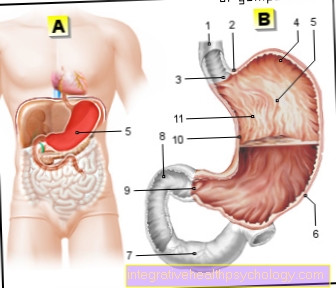marathon
Synonyms in a broader sense
- jogging
- Endurance sports
- Endurance training
- To run
- Running
- Triathlon
English: marathon
Definition of a marathon
The goal of the marathon is to leave the defined distance of 42.195 km behind in the shortest possible time.
However, the marathon is much more than just “running” this distance, it requires months of specific preparation.
Marathon runners prepare for a one-off performance, but most of them get a fever from endurance sports and the marathon becomes part of their quality of life.
contents

- history
- requirements
2.1 perseverance
2.2 Goals
2.3 Material
- Energy supply
- training
4.1 Running a marathon
4.2 Running a marathon under 3:30 hours
- nutrition
5.1 During training
5.2 Before the competition
5.3 During the competition
- personal training
- requirements
history
490 BC The messenger Pheidippides ran from Marathon to Athens to proclaim the victory over the Persians. Legend has it that he collapsed dead from exhaustion in Athens with a greeting in hand.
In 1896, at the Olympic Games in Athens, the marathon was first held as a 40 km discipline. Spyridon Louis won with a time of 2:58:50 hours.
In 1921, the International Athletics Association (IAAF) set the distance of 42.195 km as the official length of a marathon.
requirements
- Requirements for the marathon
2.1 perseverance
2.2 Goals
2.3 Material
endurance
If you want to run a marathon, you have to be in good physical condition and in good physical condition. Therefore, an examination by a doctor (ideally a sports doctor, i.e. a doctor with the additional designation sports medicine) is recommended before training. Centers that conduct performance diagnostics are particularly suitable. Not only can the fitness for endurance exercise for the 42 km run be checked here, but the fitness status and effectiveness of the training can also be checked as part of the performance diagnostics. Further information on this topic can be found under: Performance diagnostics
All training plans for a marathon that include a training scope of 3 - 4 months do not refer to the beginner athlete who has no experience in Endurance sports but on those athletes who have a solid basic endurance.
Without physical prerequisites, it makes no sense to start marathon training, since training involves very long and sometimes intense loads.
In addition, it is difficult or impossible for a beginner to cover a distance of 42,195 m with just 3 months of training.
Solid basic endurance means at least 10 kilometers in one hour without any problems to run (Jogging).
Even athletes who primarily participate in other endurance sports (swim, Cycling etc.) theirs condition Having trained to a good to very good level can manage to hold out a marathon through training.
For all athletes who do not feel their fitness level is sufficient, there is still one marathon want to run you have to improve your basic endurance beforehand, or create it first. This is done through a training in the various endurance sports, which can take up to several years depending on the level of performance.
With such a non-specific training, it is important to start with the lowest possible intensities and to regularly adapt the load to the physical condition.
To get the motivation for that Endurance training not to lose, it is advisable to
- choose different types of training (running, walking, swim, Cycling etc.)
- to change the run or route regularly and
- to train with like-minded people.
For those athletes who plan to run a marathon, that is a Training plan there is no guarantee that the marathon will be completed in a certain time or at all, it only serves as a guideline for all the factors that force the termination of a marathon (see energy supply).
However, by adhering to the training plan, the probability of surviving the marathon or of reaching the target time is very high.
aims

It is particularly important to set personal goals before starting training for a marathon.
These set goals must realistic and for everyone personally as makes sense be felt.
99,9 % all marathon runners do not run the marathon against an opponent or against themselves, but only for themselves.
Goals Help to motivate yourself for training and the marathon, even if you don't feel like training. Don't run to prove something to yourself, because the weaker self that you can overcome is often stronger than you think.
material

Anyone who wants to run a marathon should be aware that their chances can be increased many times with the right equipment.
The most important running utensil is the Running shoe / jogging shoe. The right shoe reduces the risk of impairment of the passive and active musculoskeletal system.
Due to weight gain or loss, running shoes that were very suitable a few years ago may no longer be up to date.
Detailed advice from a specialist is therefore very advisable before training. In addition, one should consider that the running shoes wear out very quickly during an intensive training program (after approx. 500 km)
Changes in the feet that tend to damage during jogging should be diagnosed and treated in advance by an orthopedic specialist.
Splayfoots, but also hammer toes, should be mentioned here in particular.
You can find more information on these topics at:
- Splay feet
- Hammer toe
Heart rate monitors help to always train in the optimal heart rate range and to keep the right speed in competition. Here, however, know-how about how to use the watch and knowledge of your own heart rate ranges are required.
Energy supply
The energy that the muscle needs for longer endurance exertion comes from the Carbohydrates (sugar) and the Fats (see energy table). The longer the load, the more fats, the shorter and more intense the load, the more
Carbohydrates are burned The fat storage of a man of normal weight would be sufficient to run about 30 marathons in a row.
The problem, however, is that the energy in fats is very difficult to convert. As a result, the body relates to strenuous activities such as a marathon gets its energy from the carbohydrate store.
However, this memory is limited and often emptied after about 30-35 km running, which leads to an unpleasant feeling.
One speaks of "Run against the wall ”, or“ from kilometer 35 the man with the hammer comes ”.
To avoid this condition, you have to pay attention to three factors when training.
The carbohydrate store must be increased through training so that the emptying of the carbohydrate store is postponed as long as possible. This is particularly important if the marathon is to be run in a specific time.
The fat burning must be improved through training so that the muscles can be supplied with sufficient energy by the fat storage even with no / few carbohydrates.
This is particularly important if the goal is not to run the marathon in a certain time, but only to complete the distance of 42 km.
Switching between the burning of carbohydrates and burning fat must be trained so that the body does not run out of energy if the carbohydrate stores are depleted.
These 3 factors also determine the training. An athlete trying to run the marathon in a set amount of time should specifically aim to increase their carbohydrate stores.
At this point we refer to our topic of endurance performance diagnostics.
Energy overview
ATP (A.denosineTri-Pphosphate) is the end product that is used for Muscle performance is needed.
The overview shows the individual ways to generate energy
- 1. Anaerobic - alactic acid: Creatine phosphate (KrP) + (ADP) -> ATP + creatine
2. Anaerobic - lactic acid: Glucose (carbohydrates) (lactate) -> ATP
3. Aerobic process: Glucose (carbohydrates) + oxygen -> ATP + H2O + CO2
4. Aerobic process: Free fatty acids + O2 -> ATP + H2O + CO2
Personal training at the marathon

More and more people are enthusiastic about marathon sport, but reaching the goal is often further away than the first impression gives. Many amateur runners try their hand at a marathon without considering the risks and problems that may arise. Those who can afford it get professional advice from a professional. Starting with training advice through to optimal training support.
Here you will find detailed information on the subject of personal training
continuation
Further information on the topics:
- training
4.1 Running a marathon
4.2 Running a marathon under 3:30 hours
- nutrition
5.1 During training
5.2 Before the competition
5.3 During the competition
can be found under our topic: Training marathon
You can also find many tips and tricks for preparation on our website: Preparation for the marathon.





























